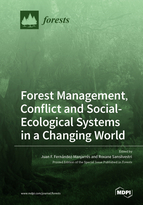Forest Management, Conflict and Social-Ecological Systems in a Changing World
A special issue of Forests (ISSN 1999-4907). This special issue belongs to the section "Forest Ecology and Management".
Deadline for manuscript submissions: closed (30 June 2021) | Viewed by 31402
Special Issue Editors
Interests: climate change adaptation; social-ecological systems; ecosystem management
Interests: social-ecological systems; forest services and goods; public policy; adaptation and mitigation; actors choices
Special Issue Information
Dear Colleagues,
Management objectives in forest social-ecological systems (FSES) are changing very fast as governments face increased pressure to limit carbon emissions and to use alternative forms of energy, while maintaining biodiversity and ecosystem restoration targets. Because actors in FSES frequently have divergent views, conflicts appear easily when applying adaptation and mitigation public policies that have not been thoroughly discussed. In this Special Issue, we present case studies in which conflicts between actors arise when facing new management goals, like intensive biomass production or strict biodiversity protection. This Special Issue will focus on conflict resolution mechanisms and the emergence of new and alternative forest management practices that maintain forest multi-functionality in a changing world.
Dr. Juan F. Fernández-Manjarrés
Dr. Roxane Sansilvestri
Guest Editors
Manuscript Submission Information
Manuscripts should be submitted online at www.mdpi.com by registering and logging in to this website. Once you are registered, click here to go to the submission form. Manuscripts can be submitted until the deadline. All submissions that pass pre-check are peer-reviewed. Accepted papers will be published continuously in the journal (as soon as accepted) and will be listed together on the special issue website. Research articles, review articles as well as short communications are invited. For planned papers, a title and short abstract (about 100 words) can be sent to the Editorial Office for announcement on this website.
Submitted manuscripts should not have been published previously, nor be under consideration for publication elsewhere (except conference proceedings papers). All manuscripts are thoroughly refereed through a single-blind peer-review process. A guide for authors and other relevant information for submission of manuscripts is available on the Instructions for Authors page. Forests is an international peer-reviewed open access monthly journal published by MDPI.
Please visit the Instructions for Authors page before submitting a manuscript. The Article Processing Charge (APC) for publication in this open access journal is 2600 CHF (Swiss Francs). Submitted papers should be well formatted and use good English. Authors may use MDPI's English editing service prior to publication or during author revisions.
Keywords
- Social-ecological systems
- Actors perceptions
- Societal Conflicts
- Conflict resolution
- Adaptation pathway/strategy
- Self-organization







